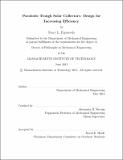Parabolic trough solar collectors : design for increasing efficiency
Author(s)
Figueredo, Stacy L. (Stacy Lee), 1981-
DownloadFull printable version (61.16Mb)
Other Contributors
Massachusetts Institute of Technology. Dept. of Mechanical Engineering.
Advisor
Alexander H. Slocum.
Terms of use
Metadata
Show full item recordAbstract
Parabolic trough collectors are a low cost implementation of concentrated solar power technology that focuses incident sunlight onto a tube filled with a heat transfer fluid. The efficiency and cost of the parabolic trough collector designs is influenced by structural stiffness, choice of materials, assembly tolerances, mirror cleanliness and wear. Current performance estimates of solar trough optical field efficiencies are 54.2% [1]. The goal of this research is to identify general methods and specific design concepts for achieving increased collector efficiency. This thesis has investigated improvements in the design of a parabolic trough module by looking first at the overall structural concept of the collector to reduce complexity while maintaining structural stability under wind loading conditions. In the process of evaluating the feasibility of one such concept, a monolithic reflector panel with a mirror film front surface, details related to the mirror surface efficiency were investigated. At the panel-structure to mirror interface, surface roughness of the underlying structural backing was studied to understand performance effects on the mirror film surface that would make one backing material potentially more suitable than another would. In this case it was found that three materials tested: gel-coated fiberglass, rolled aluminum, and rolled steel were all similarly effective when compared to a more expensive mirrored aluminum backing material. When looking at the integration of the larger structural changes with the factors that affect surface reflectivity of parabolic mirrors, it became apparent that contamination of the surfaces and cleaning were major factors in reduced module effectiveness. Given that the conceptual development of the structure is ongoing, research into contamination factors and potential cleaning solutions were considered in such a way that panel cleaning solutions could be integrated into the trough module design from the start. A vortex generator cleaning concept, which uses V-shaped extruded forms to create vortices over a mirror panel in the presence of flow over the surface, was tested as a passive cleaning solution.
Description
Thesis (Ph. D.)--Massachusetts Institute of Technology, Dept. of Mechanical Engineering, 2011. Cataloged from PDF version of thesis. Includes bibliographical references (p. 193-200).
Date issued
2011Department
Massachusetts Institute of Technology. Department of Mechanical EngineeringPublisher
Massachusetts Institute of Technology
Keywords
Mechanical Engineering.